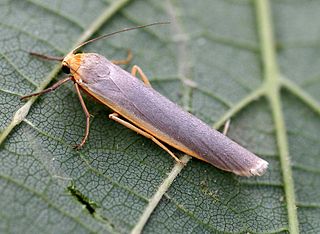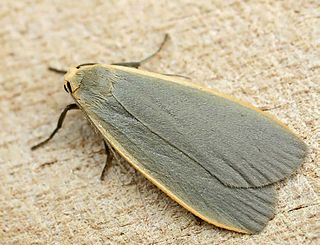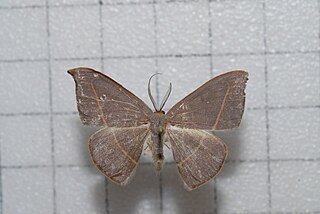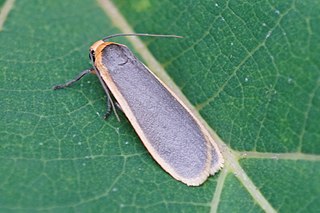
Athyma is a genus of brush-footed butterflies. They are commonly known as the "true" or "typical" sergeants, to distinguish them from the false sergeants of the genus Pseudathyma, a fairly close relative from the Adoliadini tribe. The genus ranges from Tibet to the Solomon Islands, but does not occur in New Guinea or Australia.
Collita is a genus of moths in the family Erebidae. The genus was erected by Frederic Moore in 1878.

Eilema is a genus of moths in the subfamily Arctiinae. The genus was erected by Jacob Hübner in 1819.

Manulea complana, the scarce footman, is a moth of the family Erebidae. The species was first described by Carl Linnaeus in his 1758 10th edition of Systema Naturae. It is found throughout the Palearctic region.

Collita griseola, the dingy footman, is a moth of the family Erebidae. The species was first described by Jacob Hübner in 1803. It is found in Europe and North and South-East Asia.

Wittia sororcula, the orange footman, is a moth of the family Erebidae. The species was first described by Johann Siegfried Hufnagel in 1766. It is found in Europe, Anatolia and further east across the Palearctic to southern Siberia and the Amur basin to China.
Katha is a genus of tiger moths in the family Erebidae. The genus was erected by Moore in 1878.

Manulea is a genus of moths in the family Erebidae erected by Hans Daniel Johan Wallengren in 1863. The type species is Lithosia gilveola Ochsenheimer, 1810.
Samuel Leech Maskrey was an American outfielder in Major League Baseball. He played five seasons in the majors, from 1882 to 1886, for the Louisville Eclipse/Colonels and Cincinnati Red Stockings. His brother, Harry Maskrey, was his teammate on the 1882 Eclipse.

Eilema lutarella is a species of moth in the family Erebidae. It is found in North Africa through Central Europe up to the area surrounding the Amur River and Sakhalin. In the north, it is found up to Scandinavia, Komi Republic in European Russia, Vitim river in Siberia.

Microblepsis is a genus of moths belonging to the subfamily Drepaninae.
Manulea pseudocomplana is a moth of the family Erebidae. It is found from central and southern Europe to Ukraine, Turkey and Iran.
Katha suffusa is a moth of the family Erebidae first described by John Henry Leech in 1899. It is found in western China.
Katha moorei is a moth of the family Erebidae first described by John Henry Leech in 1890. It is found in China.

Manulea japonica is a moth of the family Erebidae. It is found on the Kuril Islands (Kunashir) and in China, Korea and Japan. It has a wingspan of 25–30 mm.
Asiapistosia is a genus of moths in the subfamily Arctiinae.
Eilema fimbriata is a moth of the subfamily Arctiinae first described by John Henry Leech in 1890. It is found in central China.

Loxerebia is a butterfly genus of the subfamily Satyrinae. The genus is confined to China, Mongolia, Burma, Thailand and Laos. Most species are endemic to China.










